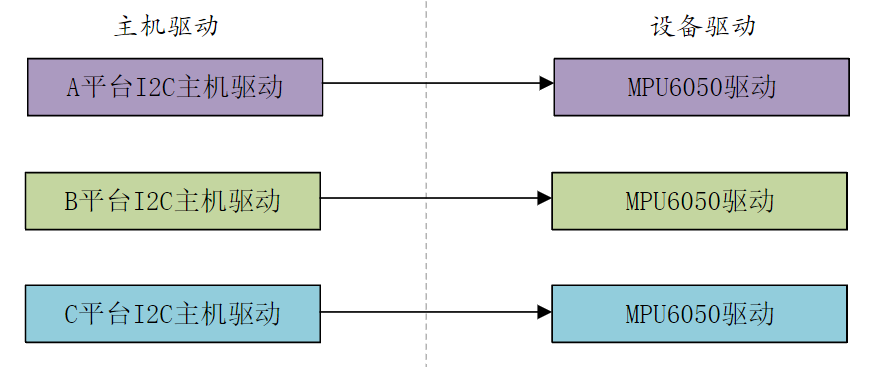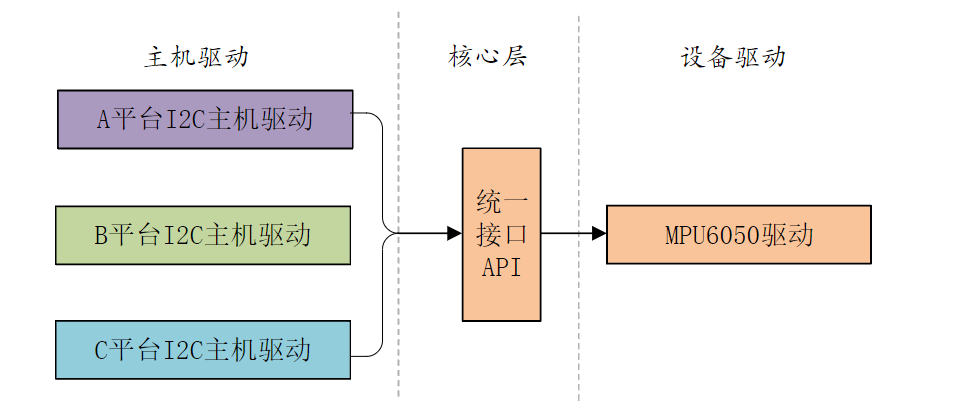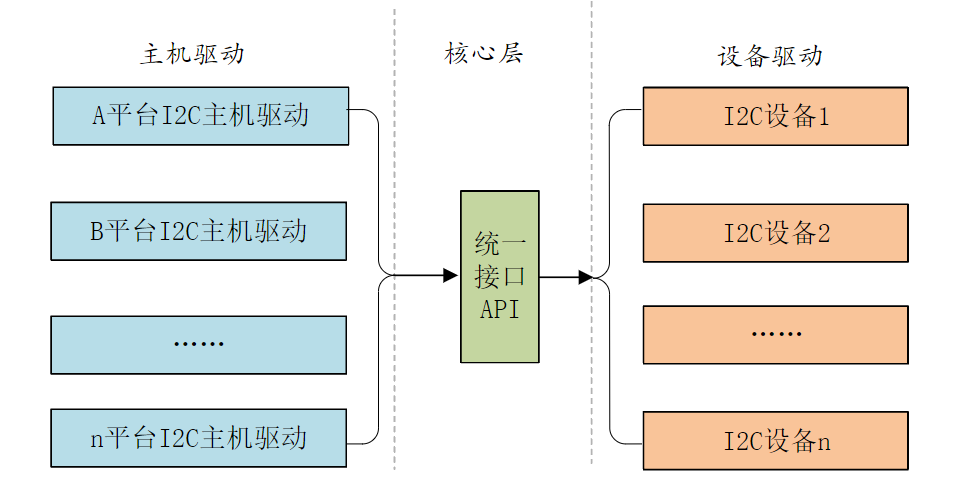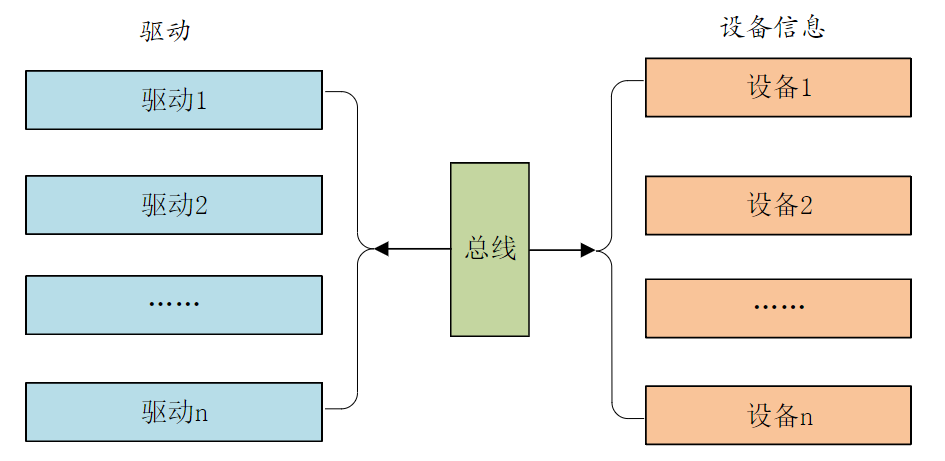我们在前面几章编写的设备驱动都非常的简单,都是对IO进行最简单的读写操作。像I2C、
SPI、LCD等这些复杂外设的驱动就不能这么去写了,Linux系统要考虑到驱动的可重用性,因
此提出了驱动的分离与分层这样的软件思路,在这个思路下诞生了我们将来最常打交道的
platform设备驱动,也叫做平台设备驱动。本章我们就来学习一下Linux下的驱动分离与分层,
以及platform框架下的设备驱动该如何编写。
1 Linux驱动的分离与分层
1.1 驱动的分隔与分离
对于Linux这样一个成熟、庞大、复杂的操作系统,代码的重用性非常重要,否则的话就
会在Linux内核中存在大量无意义的重复代码。尤其是驱动程序,因为驱动程序占用了Linux
内核代码量的大头,如果不对驱动程序加以管理,任由重复的代码肆意增加,那么用不了多久
Linux内核的文件数量就庞大到无法接受的地步。
假如现在有三个平台A、B和C,这三个平台(这里的平台说的是SOC)上都有MPU6050这
个I2C接口的六轴传感器,按照我们写裸机I2C驱动的时候的思路,每个平台都有一个MPU6050
的驱动,因此编写出来的最简单的驱动框架如图所示:

从图可以看出,每种平台下都有一个主机驱动和设备驱动,主机驱动肯定是必须要的,毕竟不同的平台其I2C控制器不同。但是右侧的设备驱动就没必要每个平台都写一个,因为不管对于那个SOC来说,MPU6050都是一样,通过I2C接口读写数据就行了,只需要一个MPU6050的驱动程序即可。如果再来几个I2C设备,比如AT24C02、FT5206(电容触摸屏)等,如果按照图中的写法,那么设备端的驱动将会重复的编写好几次。显然在Linux驱动程序中这种写法是不推荐的,最好的做法就是每个平台的I2C控制器都提供一个统一的接口(也叫做主机驱动),每个设备的话也只提供一个驱动程序(设备驱动),每个设备通过统一的I2C接口驱动来访问,这样就可以大大简化驱动文件,三种平台下的MPU6050驱动框架就可以简化为图所示:

实际的 I2C驱动设备肯定有很多种,不止 MPU6050 这一个,那么实际的驱动架构如图
所示

这个就是驱动的分隔,也就是将主机驱动和设备驱动分隔开来,比如I2C、SPI等等都会采
用驱动分隔的方式来简化驱动的开发。在实际的驱动开发中,一般I2C主机控制器驱动已经由
半导体厂家编写好了,而设备驱动一般也由设备器件的厂家编写好了,我们只需要提供设备信
息即可,比如I2C设备的话提供设备连接到了哪个I2C接口上,I2C的速度是多少等等。相当
于将设备信息从设备驱动中剥离开来,驱动使用标准方法去获取到设备信息(比如从设备树中获
取到设备信息),然后根据获取到的设备信息来初始化设备。 这样就相当于驱动只负责驱动,
设备只负责设备,想办法将两者进行匹配即可。这个就是Linux中的总线(bus)、驱动(driver)和
设备(device)模型,也就是常说的驱动分离。总线就是驱动和设备信息的月老,负责给两者牵线
搭桥,如图所示:

当我们向系统注册一个驱动的时候,总线就会在右侧的设备中查找,看看有没有与之匹配
的设备,如果有的话就将两者联系起来。同样的,当向系统中注册一个设备的时候,总线就会
在左侧的驱动中查找看有没有与之匹配的设备,有的话也联系起来。Linux内核中大量的驱动
程序都采用总线、驱动和设备模式,我们一会要重点讲解的platform驱动就是这一思想下的产
物。
1.2 驱动的分层
上一小节讲了驱动的分隔与分离,本节我们来简单看一下驱动的分层,大家应该听说过网
络的7层模型,不同的层负责不同的内容。同样的,Linux下的驱动往往也是分层的,分层的目
的也是为了在不同的层处理不同的内容。以其他书籍或者资料常常使用到的input(输入子系统,
后面会有专门的章节详细的讲解)为例,简单介绍一下驱动的分层。input子系统负责管理所有
跟输入有关的驱动,包括键盘、鼠标、触摸等,最底层的就是设备原始驱动,负责获取输入设
备的原始值,获取到的输入事件上报给input核心层。input核心层会处理各种IO模型,并且提
供file_operations操作集合。我们在编写输入设备驱动的时候只需要处理好输入事件的上报即
可,至于如何处理这些上报的输入事件那是上层去考虑的,我们不用管。可以看出借助分层模
型可以极大的简化我们的驱动编写,对于驱动编写来说非常的友好。
2 platform平台驱动模型简介
前面我们讲了设备驱动的分离,并且引出了总线(bus)、驱动(driver)和设备(device)模型,比
如I2C、SPI、USB等总线。但是在SOC中有些外设是没有总线这个概念的,但是又要使用总
线、驱动和设备模型该怎么办呢?为了解决此问题,Linux提出了platform这个虚拟总线,相应
的就有platform_driver和platform_device。
2.1 platform总线
Linux系统内核使用bus_type结构体表示总线,此结构体定义在文件include/linux/device.h,
bus_type结构体内容如下:
cpp
1 struct bus_type {
2 const char *name; /* 总线名字 */
3 const char *dev_name;
4 struct device *dev_root;
5 struct device_attribute *dev_attrs;
6 const struct attribute_group **bus_groups; /* 总线属性 */
7 const struct attribute_group **dev_groups; /* 设备属性 */
8 const struct attribute_group **drv_groups; /* 驱动属性 */
9
10 int (*match)(struct device *dev, struct device_driver *drv);
11 int (*uevent)(struct device *dev, struct kobj_uevent_env *env);
12 int (*probe)(struct device *dev);
13 int (*remove)(struct device *dev);
14 void (*shutdown)(struct device *dev);
15
16 int (*online)(struct device *dev);
17 int (*offline)(struct device *dev);
18 int (*suspend)(struct device *dev, pm_message_t state);
19 int (*resume)(struct device *dev);
20 const struct dev_pm_ops *pm;
21 const struct iommu_ops *iommu_ops;
22 struct subsys_private *p;
23 struct lock_class_key lock_key;
24 };第10行,match函数,此函数很重要,单词match的意思就是"匹配、相配",因此此函数
就是完成设备和驱动之间匹配的,总线就是使用match函数来根据注册的设备来查找对应的驱
动,或者根据注册的驱动来查找相应的设备,因此每一条总线都必须实现此函数。match函数有
两个参数:dev和drv,这两个参数分别为device和device_driver类型,也就是设备和驱动。
platform总线是bus_type的一个具体实例,定义在文件drivers/base/platform.c,platform总
线定义如下:
cpp
1 struct bus_type platform_bus_type = {
2 .name = "platform",
3 .dev_groups = platform_dev_groups,
4 .match = platform_match,
5 .uevent = platform_uevent,
6 .pm = &platform_dev_pm_ops,
7 };platform_bus_type就是platform平台总线,其中platform_match就是匹配函数。我们来看
一下驱动和设备是如何匹配的,platform_match函数定义在文件drivers/base/platform.c中,函
数内容如下所示:
cpp
1 static int platform_match(struct device *dev,
2 struct device_driver *drv)
3 {
4 struct platform_device *pdev = to_platform_device(dev);
5 struct platform_driver *pdrv = to_platform_driver(drv);
6
7 /*When driver_override is set,only bind to the matching driver*/
8 if (pdev->driver_override)
9 return !strcmp(pdev->driver_override, drv->name);
10
11 /* Attempt an OF style match first */
12 if (of_driver_match_device(dev, drv))
13 return 1;
14
15 /* Then try ACPI style match */
16 if (acpi_driver_match_device(dev, drv))
17 return 1;
18
19 /* Then try to match against the id table */
20 if (pdrv->id_table)
21 return platform_match_id(pdrv->id_table, pdev) != NULL;
22
23 /* fall-back to driver name match */
24 return (strcmp(pdev->name, drv->name) == 0);
25 }驱动和设备的匹配有四种方法,我们依次来看一下:
第 11~12 行,第一种匹配方式, OF 类型的匹配,也就是设备树采用的匹配方式,
of_driver_match_device函数定义在文件include/linux/of_device.h中。device_driver结构体(表示
设备驱动)中有个名为of_match_table的成员变量,此成员变量保存着驱动的compatible匹配表,
设备树中的每个设备节点的compatible属性会和of_match_table表中的所有成员比较,查看是
否有相同的条目,如果有的话就表示设备和此驱动匹配,设备和驱动匹配成功以后probe函数
就会执行。
第15~16行,第二种匹配方式,ACPI匹配方式。
第19~20行,第三种匹配方式,id_table匹配,每个platform_driver结构体有一个id_table
成员变量,顾名思义,保存了很多id信息。这些id信息存放着这个platformd驱动所支持的驱
动类型。
第23行,第四种匹配方式,如果第三种匹配方式的id_table不存在的话就直接比较驱动和
设备的name字段,看看是不是相等,如果相等的话就匹配成功。
对于支持设备树的Linux版本号,一般设备驱动为了兼容性都支持设备树和无设备树两种
匹配方式。也就是第一种匹配方式一般都会存在,第三种和第四种只要存在一种就可以,一般
用的最多的还是第四种,也就是直接比较驱动和设备的name字段,毕竟这种方式最简单了。
2.2 platform驱动
platform_driver 结 构 体 表 示platform 驱 动 , 此 结 构 体 定 义 在 文 件include/linux/platform_device.h中,内容如下:
cpp
1 struct platform_driver {
2 int (*probe)(struct platform_device *);
3 int (*remove)(struct platform_device *);
4 void (*shutdown)(struct platform_device *);
5 int (*suspend)(struct platform_device *, pm_message_t state);
6 int (*resume)(struct platform_device *);
7 struct device_driver driver;
8 const struct platform_device_id *id_table;
9 bool prevent_deferred_probe;
10 };第2行,probe函数,当驱动与设备匹配成功以后probe函数就会执行,非常重要的函数!!
一般驱动的提供者会编写,如果自己要编写一个全新的驱动,那么probe就需要自行实现。
第7行,driver成员,为device_driver结构体变量,Linux内核里面大量使用到了面向对象
的思维,device_driver相当于基类,提供了最基础的驱动框架。plaform_driver继承了这个基类,
然后在此基础上又添加了一些特有的成员变量。
第8行,id_table表,也就是我们上一小节讲解platform总线匹配驱动和设备的时候采用的
第三种方法,id_table 是个表(也就是数组),每个元素的类型为 platform_device_id,
platform_device_id结构体内容如下:
cpp
1 struct platform_device_id {
2 char name[PLATFORM_NAME_SIZE];
3 kernel_ulong_t driver_data;
4 }; device_driver结构体定义在include/linux/device.h,device_driver结构体内容如下:
cpp
1 struct device_driver {
2 const char *name;
3 struct bus_type *bus;
4
5 struct module *owner;
6 const char *mod_name; /* used for built-in modules */
7
8 bool suppress_bind_attrs; /* disables bind/unbind via sysfs */
9
10 const struct of_device_id *of_match_table;
11 const struct acpi_device_id *acpi_match_table;
12
13 int (*probe) (struct device *dev);
14 int (*remove) (struct device *dev);
15 void (*shutdown) (struct device *dev);
16 int (*suspend) (struct device *dev, pm_message_t state);
17 int (*resume) (struct device *dev);
18 const struct attribute_group **groups;
19
20 const struct dev_pm_ops *pm;
21
22 struct driver_private *p;
23 };第10行,of_match_table就是采用设备树的时候驱动使用的匹配表,同样是数组,每个匹
配项都为of_device_id结构体类型,此结构体定义在文件include/linux/mod_devicetable.h中,内
容如下:
cpp
1 struct of_device_id {
2 char name[32];
3 char type[32];
4 char compatible[128];
5 const void *data;
6 };第4行的compatible非常重要,因为对于设备树而言,就是通过设备节点的compatible属
性值和of_match_table中每个项目的compatible成员变量进行比较,如果有相等的就表示设备
和此驱动匹配成功。
在编写platform驱动的时候,首先定义一个platform_driver结构体变量,然后实现结构体
中的各个成员变量,重点是实现匹配方法以及probe函数。当驱动和设备匹配成功以后probe
函数就会执行,具体的驱动程序在probe函数里面编写,比如字符设备驱动等等。
当我们定义并初始化好 platform_driver 结构体变量以后,需要在驱动入口函数里面调用
platform_driver_register函数向Linux内核注册一个platform驱动,platform_driver_register函数
原型如下所示:
cpp
int platform_driver_register (struct platform_driver *driver) 还需要在驱动卸载函数中通过 platform_driver_unregister 函数卸载 platform 驱动,
platform_driver_unregister函数原型如下:
cpp
void platform_driver_unregister(struct platform_driver *drv) platform驱动框架如下所示:
cpp
/* 设备结构体 */
1 struct xxx_dev{
2 struct cdev cdev;
3 /* 设备结构体其他具体内容 */
4 };
5
6 struct xxx_dev xxxdev; /* 定义个设备结构体变量 */
7
8 static int xxx_open(struct inode *inode, struct file *filp)
9 {
10 /* 函数具体内容 */
11 return 0;
12 }
13
14 static ssize_t xxx_write(struct file *filp, const char __user *buf, size_t cnt, loff_t *offt)
15 {
16 /* 函数具体内容 */
17 return 0;
18 }
19
20 /*
21 * 字符设备驱动操作集
22 */
23 static struct file_operations xxx_fops = {
24 .owner = THIS_MODULE,
25 .open = xxx_open,
26 .write = xxx_write,
27 };
28
29 /*
30 * platform驱动的probe函数
31 * 驱动与设备匹配成功以后此函数就会执行
32 */
33 static int xxx_probe(struct platform_device *dev)
34 {
35 ......
36 cdev_init(&xxxdev.cdev, &xxx_fops); /* 注册字符设备驱动 */
37 /* 函数具体内容 */
38 return 0;
39 }
40
41 static int xxx_remove(struct platform_device *dev)
42 {
43 ......
44 cdev_del(&xxxdev.cdev);/* 删除cdev */
45 /* 函数具体内容 */
46 return 0;
47 }
48
49 /* 匹配列表 */
50 static const struct of_device_id xxx_of_match[] = {
51 { .compatible = "xxx-gpio" },
52 { /* Sentinel */ }
53 };
54
55 /*
56 * platform平台驱动结构体
57 */
58 static struct platform_driver xxx_driver = {
59 .driver = {
60 .name = "xxx",
61 .of_match_table = xxx_of_match,
62 },
63 .probe = xxx_probe,
64 .remove = xxx_remove,
65 };
66
67 /* 驱动模块加载 */
68 static int __init xxxdriver_init(void)
69 {
70 return platform_driver_register(&xxx_driver);
71 }
72
73 /* 驱动模块卸载 */
74 static void __exit xxxdriver_exit(void)
75 {
76 platform_driver_unregister(&xxx_driver);
77 }
78
79 module_init(xxxdriver_init);
80 module_exit(xxxdriver_exit);
81 MODULE_LICENSE("GPL");
82 MODULE_AUTHOR("zuozhongkai");第1~27行,传统的字符设备驱动,所谓的platform驱动并不是独立于字符设备驱动、块设
备驱动和网络设备驱动之外的其他种类的驱动。platform只是为了驱动的分离与分层而提出来
的一种框架,其驱动的具体实现还是需要字符设备驱动、块设备驱动或网络设备驱动。
第33~39行,xxx_probe函数,当驱动和设备匹配成功以后此函数就会执行,以前在驱动
入口init函数里面编写的字符设备驱动程序就全部放到此probe函数里面。比如注册字符设备
驱动、添加cdev、创建类等等。
第41~47行,xxx_remove函数,platform_driver结构体中的remove成员变量,当关闭platfor
备驱动的时候此函数就会执行,以前在驱动卸载exit函数里面要做的事情就放到此函数中来。
比如,使用iounmap释放内存、删除cdev,注销设备号等等。
第50~53行,xxx_of_match匹配表,如果使用设备树的话将通过此匹配表进行驱动和设备
的匹配。第51行设置了一个匹配项,此匹配项的compatible值为"xxx-gpio",因此当设备树中
设备节点的compatible属性值为"xxx-gpio"的时候此设备就会与此驱动匹配。第52行是一个
标记,of_device_id表最后一个匹配项必须是空的。
第58~65行,定义一个platform_driver结构体变量xxx_driver,表示platform驱动,第59~62
行设置paltform_driver中的device_driver成员变量的name和of_match_table这两个属性。其中
name 属性用于传统的驱动与设备匹配,也就是检查驱动和设备的 name 字段是不是相同。
of_match_table属性就是用于设备树下的驱动与设备检查。对于一个完整的驱动程序,必须提供
有设备树和无设备树两种匹配方法。最后63和64这两行设置probe和remove这两成员变量。
第68~71行,驱动入口函数,调用platform_driver_register函数向Linux内核注册一个platform
驱动,也就是上面定义的xxx_driver结构体变量。
第74~77行,驱动出口函数,调用platform_driver_unregister函数卸载前面注册的platform
驱动。
总体来说,platform驱动还是传统的字符设备驱动、块设备驱动或网络设备驱动,只是套
上了一张"platform"的皮,目的是为了使用总线、驱动和设备这个驱动模型来实现驱动的分
离与分层。
2.3 platform设备
platform驱动已经准备好了,我们还需要platform设备,否则的话单单一个驱动也做不了
什么。platform_device这个结构体表示platform设备,这里我们要注意,如果内核支持设备树
的话就不要再使用platform_device来描述设备了,因为改用设备树去描述了。当然了,你如果
一定要用platform_device来描述设备信息的话也是可以的。platform_device结构体定义在文件
include/linux/platform_device.h中,结构体内容如下:
cpp
22 struct platform_device {
23 const char *name;
24 int id;
25 bool id_auto;
26 struct device dev;
27 u32 num_resources;
28 struct resource *resource;
29
30 const struct platform_device_id *id_entry;
31 char *driver_override; /* Driver name to force a match */
32
33 /* MFD cell pointer */
34 struct mfd_cell *mfd_cell;
35
36 /* arch specific additions */
37 struct pdev_archdata archdata;
38 };第23行,name表示设备名字,要和所使用的platform驱动的name字段相同,否则的话设
备就无法匹配到对应的驱动。比如对应的platform驱动的name字段为"xxx-gpio",那么此name
字段也要设置为"xxx-gpio"。
第27行,num_resources表示资源数量,一般为第28行resource资源的大小。
第28行,resource表示资源,也就是设备信息,比如外设寄存器等。Linux内核使用resource
结构体表示资源,resource结构体内容如下:
cpp
8 struct resource {
19 resource_size_t start;
20 resource_size_t end;
21 const char *name;
22 unsigned long flags;
23 struct resource *parent, *sibling, *child;
24 };start和end分别表示资源的起始和终止信息,对于内存类的资源,就表示内存起始和终止
地址,name 表示资源名字,flags 表示资源类型,可选的资源类型都定义在了文件
include/linux/ioport.h里面,如下所示:
cpp
29 #define IORESOURCE_BITS 0x000000ff /* Bus-specific bits */
30
31 #define IORESOURCE_TYPE_BITS 0x00001f00 /* Resource type */
32 #define IORESOURCE_IO 0x00000100 /* PCI/ISA I/O ports */
33 #define IORESOURCE_MEM 0x00000200
34 #define IORESOURCE_REG 0x00000300 /* Register offsets */
35 #define IORESOURCE_IRQ 0x00000400
36 #define IORESOURCE_DMA 0x00000800
37 #define IORESOURCE_BUS 0x00001000
......
104 /* PCI control bits. Shares IORESOURCE_BITS with above PCI ROM. */
105 #define IORESOURCE_PCI_FIXED (1<<4) /* Do not move resource */在以前不支持设备树的Linux版本中,用户需要编写platform_device变量来描述设备信息,
然后使用platform_device_register函数将设备信息注册到Linux内核中,此函数原型如下所示:
cpp
int platform_device_register(struct platform_device *pdev) 如果不再使用platform的话可以通过platform_device_unregister函数注销掉相应的platform
设备,platform_device_unregister函数原型如下:
cpp
void platform_device_unregister(struct platform_device *pdev) platform设备信息框架如下所示:
cpp
1 /* 寄存器地址定义*/
2 #define PERIPH1_REGISTER_BASE (0X20000000) /* 外设1寄存器首地址 */
3 #define PERIPH2_REGISTER_BASE (0X020E0068) /* 外设2寄存器首地址 */
4 #define REGISTER_LENGTH 4
5
6 /* 资源 */
7 static struct resource xxx_resources[] = {
8 [0] = {
9 .start = PERIPH1_REGISTER_BASE,
10 .end = (PERIPH1_REGISTER_BASE + REGISTER_LENGTH - 1),
11 .flags = IORESOURCE_MEM,
12 },
13 [1] = {
14 .start = PERIPH2_REGISTER_BASE,
15 .end = (PERIPH2_REGISTER_BASE + REGISTER_LENGTH - 1),
16 .flags = IORESOURCE_MEM,
17 },
18 };
19
20 /* platform设备结构体 */
21 static struct platform_device xxxdevice = {
22 .name = "xxx-gpio",
23 .id = -1,
24 .num_resources = ARRAY_SIZE(xxx_resources),
25 .resource = xxx_resources,
26 };
27
28 /* 设备模块加载 */
29 static int __init xxxdevice_init(void)
30 {
31 return platform_device_register(&xxxdevice);
32 }
33
34 /* 设备模块注销 */
35 static void __exit xxx_resourcesdevice_exit(void)
36 {
37 platform_device_unregister(&xxxdevice);
38 }
39
40 module_init(xxxdevice_init);
41 module_exit(xxxdevice_exit);
42 MODULE_LICENSE("GPL");
43 MODULE_AUTHOR("zuozhongkai");第7~18行,数组xxx_resources表示设备资源,一共有两个资源,分别为设备外设1和外
设2的寄存器信息。因此flags都为IORESOURCE_MEM,表示资源为内存类型的。
第21~26行,platform设备结构体变量,注意name字段要和所使用的驱动中的name字段
一致,否则驱动和设备无法匹配成功。num_resources表示资源大小,其实就是数组xxx_resources
的元素数量,这里用ARRAY_SIZE来测量一个数组的元素个数。
第29~32行,设备模块加载函数,在此函数中调用platform_device_register向Linux内核注
册platform设备。
第35~38行,设备模块卸载函数,在此函数中调用platform_device_unregister从Linux内核
中卸载platform设备。
示例代码主要是在不支持设备树的Linux版本中使用的,当Linux内核支持了设备树以后就不需要用户手动去注册platform设备了。因为设备信息都放到了设备树中去描述,Linux内核启动的时候会从设备树中读取设备信息,然后将其组织成platform_device形式,至于设备树到platform_device的具体过程就不去详细的追究了,感兴趣的可以去看一下,网上也有很多博客详细的讲解了整个过程。
关于platform下的总线、驱动和设备就讲解到这里,我们接下来就使用platform驱动框架来编写一个 LED 灯驱动,本章我们不使用设备树来描述设备信息,我们采用自定义platform_device这种"古老"方式来编写LED的设备信息。下一章我们来编写设备树下的platform驱动,这样我们就掌握了无设备树和有设备树这两种platform驱动的开发方式。
3 试验程序编写
本实验对应的例程路径为:开发板光盘-> 2、Linux驱动例程-> 17_platform。
本章实验我们需要编写一个驱动模块和一个设备模块,其中驱动模块是platform驱动程序,
设备模块是platform的设备信息。当这两个模块都加载成功以后就会匹配成功,然后platform
驱动模块中的probe函数就会执行,probe函数中就是传统的字符设备驱动那一套。
3.1 platform设备与驱动程序编写
新建名为"17_platform"的文件夹,然后在17_platform文件夹里面创建vscode工程,工作
区命名为"platform"。新建名为leddevice.c和leddriver.c这两个文件,这两个文件分别为LED
灯的platform设备文件和LED灯的platform的驱动文件。在leddevice.c中输入如下所示内容:
cpp
1 #include <linux/types.h>
2 #include <linux/kernel.h>
3 #include <linux/delay.h>
4 #include <linux/ide.h>
5 #include <linux/init.h>
6 #include <linux/module.h>
7 #include <linux/errno.h>
8 #include <linux/gpio.h>
9 #include <linux/cdev.h>
10 #include <linux/device.h>
11 #include <linux/of_gpio.h>
12 #include <linux/semaphore.h>
13 #include <linux/timer.h>
14 #include <linux/irq.h>
15 #include <linux/wait.h>
16 #include <linux/poll.h>
17 #include <linux/fs.h>
18 #include <linux/fcntl.h>
19 #include <linux/platform_device.h>
20 #include <asm/mach/map.h>
21 #include <asm/uaccess.h>
22 #include <asm/io.h>
23 /***************************************************************
24 Copyright © ALIENTEK Co., Ltd. 1998-2029. All rights reserved.
25 文件名 : leddevice.c
26 作者 : 左忠凯
27 版本 : V1.0
28 描述 : platform设备
29 其他 : 无
30 论坛 : www.openedv.com
31 日志 : 初版V1.0 2019/8/13 左忠凯创建
32 ***************************************************************/
33
34 /*
35 * 寄存器地址定义
36 */
37 #define CCM_CCGR1_BASE (0X020C406C)
38 #define SW_MUX_GPIO1_IO03_BASE (0X020E0068)
39 #define SW_PAD_GPIO1_IO03_BASE (0X020E02F4)
40 #define GPIO1_DR_BASE (0X0209C000)
41 #define GPIO1_GDIR_BASE (0X0209C004)
42 #define REGISTER_LENGTH 4
43
44 /* @description : 释放flatform设备模块的时候此函数会执行
45 * @param - dev : 要释放的设备
46 * @return : 无
47 */
48 static void led_release(struct device *dev)
49 {
50 printk("led device released!\r\n");
51 }
52
53 /*
54 * 设备资源信息,也就是LED0所使用的所有寄存器
55 */
56 static struct resource led_resources[] = {
57 [0] = {
58 .start = CCM_CCGR1_BASE,
59 .end = (CCM_CCGR1_BASE + REGISTER_LENGTH - 1),
60 .flags = IORESOURCE_MEM,
61 },
62 [1] = {
63 .start = SW_MUX_GPIO1_IO03_BASE,
64 .end = (SW_MUX_GPIO1_IO03_BASE + REGISTER_LENGTH - 1),
65 .flags = IORESOURCE_MEM,
66 },
67 [2] = {
68 .start = SW_PAD_GPIO1_IO03_BASE,
69 .end = (SW_PAD_GPIO1_IO03_BASE + REGISTER_LENGTH - 1),
70 .flags = IORESOURCE_MEM,
71 },
72 [3] = {
73 .start = GPIO1_DR_BASE,
74 .end = (GPIO1_DR_BASE + REGISTER_LENGTH - 1),
75 .flags = IORESOURCE_MEM,
76 },
77 [4] = {
78 .start = GPIO1_GDIR_BASE,
79 .end = (GPIO1_GDIR_BASE + REGISTER_LENGTH - 1),
80 .flags = IORESOURCE_MEM,
81 },
82 };
83
84
85 /*
86 * platform设备结构体
87 */
88 static struct platform_device leddevice = {
89 .name = "imx6ul-led",
90 .id = -1,
91 .dev = {
92 .release = &led_release,
93 },
94 .num_resources = ARRAY_SIZE(led_resources),
95 .resource = led_resources,
96 };
97
98 /*
99 * @description : 设备模块加载
100 * @param : 无
101 * @return : 无
102 */
103 static int __init leddevice_init(void)
104 {
105 return platform_device_register(&leddevice);
106 }
107
108 /*
109 * @description : 设备模块注销
110 * @param : 无
111 * @return : 无
112 */
113 static void __exit leddevice_exit(void)
114 {
115 platform_device_unregister(&leddevice);
116 }
117
118 module_init(leddevice_init);
119 module_exit(leddevice_exit);
120 MODULE_LICENSE("GPL");
121 MODULE_AUTHOR("zuozhongkai"); leddevice.c文件内容就是按照示例代码的platform设备模板编写的。
第56~82行,led_resources数组,也就是设备资源,描述了LED所要使用到的寄存器信息,
也就是IORESOURCE_MEM资源。
第88~96,platform设备结构体变量leddevice,这里要注意name字段为"imx6ul-led",所
以稍后编写platform驱动中的name字段也要为"imx6ul-led",否则设备和驱动匹配失败。
第103~106行,设备模块加载函数,在此函数里面通过platform_device_register向Linux内
核注册leddevice这个platform设备。
第113~116行,设备模块卸载函数,在此函数里面通过platform_device_unregister从Linux
内核中删除掉leddevice这个platform设备。
leddevice.c文件编写完成以后就编写leddriver.c这个platform驱动文件,在leddriver.c里
面输入如下内容:
cpp
1 #include <linux/types.h>
2 #include <linux/kernel.h>
3 #include <linux/delay.h>
4 #include <linux/ide.h>
5 #include <linux/init.h>
6 #include <linux/module.h>
7 #include <linux/errno.h>
8 #include <linux/gpio.h>
9 #include <linux/cdev.h>
10 #include <linux/device.h>
11 #include <linux/of_gpio.h>
12 #include <linux/semaphore.h>
13 #include <linux/timer.h>
14 #include <linux/irq.h>
15 #include <linux/wait.h>
16 #include <linux/poll.h>
17 #include <linux/fs.h>
18 #include <linux/fcntl.h>
19 #include <linux/platform_device.h>
20 #include <asm/mach/map.h>
21 #include <asm/uaccess.h>
22 #include <asm/io.h>
23 /***************************************************************
24 Copyright © ALIENTEK Co., Ltd. 1998-2029. All rights reserved.
25 文件名 : leddriver.c
26 作者 : 左忠凯
27 版本 : V1.0
28 描述 : platform驱动
29 其他 : 无
30 论坛 : www.openedv.com
31 日志 : 初版V1.0 2019/8/13 左忠凯创建
32 ***************************************************************/
33
34 #define LEDDEV_CNT 1 /* 设备号长度 */
35 #define LEDDEV_NAME "platled" /* 设备名字 */
36 #define LEDOFF 0
37 #define LEDON 1
38
39 /* 寄存器名 */
40 static void __iomem *IMX6U_CCM_CCGR1;
41 static void __iomem *SW_MUX_GPIO1_IO03;
42 static void __iomem *SW_PAD_GPIO1_IO03;
43 static void __iomem *GPIO1_DR;
44 static void __iomem *GPIO1_GDIR;
45
46 /* leddev设备结构体 */
47 struct leddev_dev{
48 dev_t devid; /* 设备号 */
49 struct cdev cdev; /* cdev */
50 struct class *class; /* 类 */
51 struct device *device; /* 设备 */
52 int major; /* 主设备号 */
53 };
54
55 struct leddev_dev leddev; /* led设备 */
56
57 /*
58 * @description : LED打开/关闭
59 * @param - sta : LEDON(0) 打开LED,LEDOFF(1) 关闭LED
60 * @return : 无
61 */
62 void led0_switch(u8 sta)
63 {
64 u32 val = 0;
65 if(sta == LEDON){
66 val = readl(GPIO1_DR);
67 val &= ~(1 << 3);
68 writel(val, GPIO1_DR);
69 }else if(sta == LEDOFF){
70 val = readl(GPIO1_DR);
71 val|= (1 << 3);
72 writel(val, GPIO1_DR);
73 }
74 }
75
76 /*
77 * @description : 打开设备
78 * @param -- inode : 传递给驱动的inode
79 * @param - filp : 设备文件,file结构体有个叫做private_data的成员变量
80 * 一般在open的时候将private_data指向设备结构体。
81 * @return : 0 成功;其他 失败
82 */
83 static int led_open(struct inode *inode, struct file *filp)
84 {
85 filp->private_data = &leddev; /* 设置私有数据 */
86 return 0;
87 }
88
89 /*
90 * @description : 向设备写数据
91 * @param -- filp : 设备文件,表示打开的文件描述符
92 * @param - buf : 要写给设备写入的数据
93 * @param - cnt : 要写入的数据长度
94 * @param - offt : 相对于文件首地址的偏移
95 * @return : 写入的字节数,如果为负值,表示写入失败
96 */
97 static ssize_t led_write(struct file *filp, const char __user *buf,
size_t cnt, loff_t *offt)
98 {
99 int retvalue;
100 unsigned char databuf[1];
101 unsigned char ledstat;
102
103 retvalue = copy_from_user(databuf, buf, cnt);
104 if(retvalue < 0) {
105 return -EFAULT;
106 }
107
108 ledstat = databuf[0]; /* 获取状态值 */
109 if(ledstat == LEDON) {
110 led0_switch(LEDON); /* 打开LED灯 */
111 }else if(ledstat == LEDOFF) {
112 led0_switch(LEDOFF); /* 关闭LED灯 */
113 }
114 return 0;
115 }
116
117 /* 设备操作函数 */
118 static struct file_operations led_fops = {
119 .owner = THIS_MODULE,
120 .open = led_open,
121 .write = led_write,
122 };
123
124 /*
125 * @description : flatform驱动的probe函数,当驱动与设备
126 * 匹配以后此函数就会执行
127 * @param - dev : platform设备
128 * @return : 0,成功;其他负值,失败
129 */
130 static int led_probe(struct platform_device *dev)
131 {
132 int i = 0;
133 int ressize[5];
134 u32 val = 0;
135 struct resource *ledsource[5];
136
137 printk("led driver and device has matched!\r\n");
138 /* 1、获取资源 */
139 for (i = 0; i < 5; i++) {
140 ledsource[i] = platform_get_resource(dev, IORESOURCE_MEM, i);
141 if (!ledsource[i]) {
142 dev_err(&dev->dev, "No MEM resource for always on\n");
143 return -ENXIO;
144 }
145 ressize[i] = resource_size(ledsource[i]);
146 }
147
148 /* 2、初始化LED */
149 /* 寄存器地址映射 */
150 IMX6U_CCM_CCGR1 = ioremap(ledsource[0]->start, ressize[0]);
151 SW_MUX_GPIO1_IO03 = ioremap(ledsource[1]->start, ressize[1]);
152 SW_PAD_GPIO1_IO03 = ioremap(ledsource[2]->start, ressize[2]);
153 GPIO1_DR = ioremap(ledsource[3]->start, ressize[3]);
154 GPIO1_GDIR = ioremap(ledsource[4]->start, ressize[4]);
155
156 val = readl(IMX6U_CCM_CCGR1);
157 val &= ~(3 << 26); /* 清除以前的设置 */
158 val |= (3 << 26); /* 设置新值 */
159 writel(val, IMX6U_CCM_CCGR1);
160
161 /* 设置GPIO1_IO03复用功能,将其复用为GPIO1_IO03 */
162 writel(5, SW_MUX_GPIO1_IO03);
163 writel(0x10B0, SW_PAD_GPIO1_IO03);
164
165 /* 设置GPIO1_IO03为输出功能 */
166 val = readl(GPIO1_GDIR);
167 val &= ~(1 << 3); /* 清除以前的设置 */
168 val |= (1 << 3); /* 设置为输出 */
169 writel(val, GPIO1_GDIR);
170
171 /* 默认关闭LED1 */
172 val = readl(GPIO1_DR);
173 val |= (1 << 3) ;
174 writel(val, GPIO1_DR);
175
176 /* 注册字符设备驱动 */
177 /*1、创建设备号 */
178 if (leddev.major) { /* 定义了设备号 */
179 leddev.devid = MKDEV(leddev.major, 0);
180 register_chrdev_region(leddev.devid, LEDDEV_CNT, LEDDEV_NAME);
181 } else { /* 没有定义设备号 */
182 alloc_chrdev_region(&leddev.devid, 0, LEDDEV_CNT, LEDDEV_NAME);
183 leddev.major = MAJOR(leddev.devid);
184 }
185
186 /* 2、初始化cdev */
187 leddev.cdev.owner = THIS_MODULE;
188 cdev_init(&leddev.cdev, &led_fops);
189
190 /* 3、添加一个cdev */
191 cdev_add(&leddev.cdev, leddev.devid, LEDDEV_CNT);
192
193 /* 4、创建类 */
194 leddev.class = class_create(THIS_MODULE, LEDDEV_NAME);
195 if (IS_ERR(leddev.class)) {
196 return PTR_ERR(leddev.class);
197 }
198
199 /* 5、创建设备 */
200 leddev.device = device_create(leddev.class, NULL, leddev.devid,NULL,LEDDEV_NAME);
201 if (IS_ERR(leddev.device)) {
202 return PTR_ERR(leddev.device);
203 }
204
205 return 0;
206 }
207
208 /*
209 * @description :移除platform驱动的时候此函数会执行
210 * @param - dev : platform设备
211 * @return : 0,成功;其他负值,失败
212 */
213 static int led_remove(struct platform_device *dev)
214 {
215 iounmap(IMX6U_CCM_CCGR1);
216 iounmap(SW_MUX_GPIO1_IO03);
217 iounmap(SW_PAD_GPIO1_IO03);
218 iounmap(GPIO1_DR);
219 iounmap(GPIO1_GDIR);
220
221 cdev_del(&leddev.cdev); /* 删除cdev */
222 unregister_chrdev_region(leddev.devid, LEDDEV_CNT);
223 device_destroy(leddev.class, leddev.devid);
224 class_destroy(leddev.class);
225 return 0;
226 }
227
228 /* platform驱动结构体 */
229 static struct platform_driver led_driver = {
230 .driver = {
231 .name = "imx6ul-led", /* 驱动名字,用于和设备匹配 */
232 },
233 .probe = led_probe,
234 .remove = led_remove,
235 };
236
237 /*
238 * @description : 驱动模块加载函数
239 * @param : 无
240 * @return : 无
241 */
242 static int __init leddriver_init(void)
243 {
244 return platform_driver_register(&led_driver);
245 }
246
247 /*
248 * @description : 驱动模块卸载函数
249 * @param : 无
250 * @return : 无
251 */
252 static void __exit leddriver_exit(void)
253 {
254 platform_driver_unregister(&led_driver);
255 }
256
257 module_init(leddriver_init);
258 module_exit(leddriver_exit);
259 MODULE_LICENSE("GPL");
260 MODULE_AUTHOR("zuozhongkai");leddriver.c文件内容就是按照示例代码的platform驱动模板编写的。
第34~122行,传统的字符设备驱动。
第130~206行,probe函数,当设备和驱动匹配以后此函数就会执行,当匹配成功以后会在
终端上输出"led driver and device has matched!"这样语句。在probe函数里面初始化LED、注
册字符设备驱动。也就是将原来在驱动加载函数里面做的工作全部放到probe函数里面完成。
第213~226行,remobe函数,当卸载platform驱动的时候此函数就会执行。在此函数里面
释放内存、注销字符设备等。也就是将原来驱动卸载函数里面的工作全部都放到remove函数中
完成。
第 229~235行,platform_driver驱动结构体,注意name字段为"imx6ul-led",和我们在
leddevice.c文件里面设置的设备name字段一致。
第242~245行,驱动模块加载函数,在此函数里面通过platform_driver_register向Linux内
核注册led_driver驱动。
第252~255行,驱动模块卸载函数,在此函数里面通过platform_driver_unregister从Linux
内核卸载led_driver驱动。
3.2 测试APP编写
测试APP的内容很简单,就是打开和关闭LED灯,新建ledApp.c这个文件,然后在里面
输入如下内容:
cpp
1 #include "stdio.h"
2 #include "unistd.h"
3 #include "sys/types.h"
4 #include "sys/stat.h"
5 #include "fcntl.h"
6 #include "stdlib.h"
7 #include "string.h"
8 /***************************************************************
9 Copyright © ALIENTEK Co., Ltd. 1998-2029. All rights reserved.
10 文件名 : ledApp.c
11 作者 : 左忠凯
12 版本 : V1.0
13 描述 : platform驱动驱测试APP。
14 其他 : 无
15 使用方法 :./ledApp /dev/platled 0 关闭LED
16 ./ledApp /dev/platled 1 打开LED
17 论坛 : www.openedv.com
18 日志 : 初版V1.0 2019/8/16 左忠凯创建
19 ***************************************************************/
20 #define LEDOFF 0
21 #define LEDON 1
22 /*
23 * @description : main主程序
24 * @param - argc : argv数组元素个数
25 * @param - argv : 具体参数
26 * @return : 0 成功;其他 失败
27 */
28 int main(int argc, char *argv[])
29 {
30 int fd, retvalue;
31 char *filename;
32 unsigned char databuf[2];
33
34 if(argc != 3){
35 printf("Error Usage!\r\n");
36 return -1;
37 }
38
39 filename = argv[1];
40 /* 打开led驱动 */
41 fd = open(filename, O_RDWR);
42 if(fd < 0){
43 printf("file %s open failed!\r\n", argv[1]);
44 return -1;
45 }
46
47 databuf[0] = atoi(argv[2]); /* 要执行的操作:打开或关闭 */
48 retvalue = write(fd, databuf, sizeof(databuf));
49 if(retvalue < 0){
50 printf("LED Control Failed!\r\n");
51 close(fd);
52 return -1;
53 }
54
55 retvalue = close(fd); /* 关闭文件 */
56 if(retvalue < 0){
57 printf("file %s close failed!\r\n", argv[1]);
58 return -1;
59 }
60
61 return 0;
62 }输入如下命令加载leddevice.ko设备模块和leddriver.ko这个驱动模块。
cpp
depmod //第一次加载驱动的时候需要运行此命令
modprobe leddevice.ko //加载设备模块
modprobe leddriver.ko //加载驱动模块 根文件系统中/sys/bus/platform/目录下保存着当前板子platform总线下的设备和驱动,其中
devices子目录为platform设备,drivers子目录为plartofm驱动。查看/sys/bus/platform/devices/
目录,看看我们的设备是否存在,我们在leddevice.c中设置leddevice(platform_device类型)的
name字段为"imx6ul-led",也就是设备名字为imx6ul-led,因此肯定在/sys/bus/platform/devices/
目录下存在一个名字"imx6ul-led"的文件,否则说明我们的设备模块加载失败,结果如图

同理,查看/sys/bus/platform/drivers/目录,看一下驱动是否存在,我们在leddriver.c中设置
led_driver (platform_driver类型)的name字段为"imx6ul-led",因此会在/sys/bus/platform/drivers/
目录下存在名为"imx6ul-led"这个文件,结果如图

驱动模块和设备模块加载成功以后platform总线就会进行匹配,当驱动和设备匹配成功以
后就会输出如图所示一行语句:
